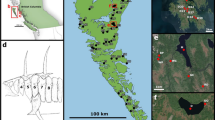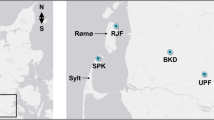Abstract
Fluctuating asymmetry (FA), random deviations from perfect symmetry in a bilateral organism, has been widely used as a proxy for developmental instability in stressed populations. In order to test the utility of FA of resident freshwater threespine stickleback (Gasterosteus aculeatus) as a biomonitoring tool for contaminated sites, we compared levels of asymmetry of seven morphological traits of threespine stickleback collected from lakes at three islands with a history of military contamination and three islands with no military history, in the Aleutian Archipelago, Alaska. Traits examined include eye diameter, operculum width, pectoral fin ray number, pectoral fin width, lateral plate number, lateral plate length, and pelvic spine length. All morphometric traits demonstrated some degree of FA or directional asymmetry (DA), but the military history of a lake was not a predictor of the degree or type of asymmetry. Overall, the patterns of asymmetry were similar for all traits, irrespective of military contamination at a lake. Our results demonstrate that the suite of threespine stickleback traits measured are not suitable for examination of FA as a proxy for aquatic pollution in this region. DA also does not appear to be suitable as an indicator of aquatic pollution, but may instead be driven by local ecological factors such as predation.




Similar content being viewed by others
References
Al-Shami SA, Salmah MRC, Hassan AA, Azizah MNS (2011) Fluctuating asymmetry of Chironomus spp. (Diptera: Chironomidae) larvae in association with water quality and metal pollution in Permatang Rawa River in the Juru River Basin, Penang, Malaysia. Water Air Soil Poll 216:203–216
Anthony RG, Miles AK, Ricca MA, Estes JA (2007) Environmental contaminants in bald eagle eggs from the Aleutian Archipelago. Environ Toxicol Chem 26:1843–1855
Bell MA (2001) Lateral plate evolution in the threespine stickleback: getting nowhere fast. Genetica 112–113:445–461
Bell MA, Francis RC, Havens AC (1985) Pelvic reduction and its directional asymmetry in threespine sticklebacks from the Cook Inlet region, Alaska. Copeia 1985: 437–444
Bell MA, Foster SA (1994) Introduction to the evolutionary biology of the threespine stickleback. In: Bell MA, Foster SA (eds) The evolutionary biology of the threespine stickleback. Oxford University Press, Oxford, pp 1–27
Bell MA, Ellis KE, Sirotkin HI (2007) Pelvic skeleton reduction and Pitx1 expression in threespine stickleback populations. Novartis Found Symp 284:225–244
Bergstrom CA, Reimchen TE (2000) Functional implications of fluctuating asymmetry among endemic populations of Gasterosteus aculeatus. Behav 137:1097–1112
Bergstrom CA, Reimchen TE (2005) Habitat-dependent associations between parasitism and fluctuating asymmetry among endemic stickleback populations. J Evol Biol 18:939–948
Bjorksten TA, Fowler K, Pomiankowski A (2000) What does sexual trait FA tell us about stress? Trends Ecol Evol 15:163–166
Bustnes JO, Folstad I, Erikstad KE, Fjeld M, Miland ØO, Skaare JU (2002) Blood concentrations of organochlorine pollutants and wing feather asymmetry in glaucous gull. Funct Ecol 16:617–622
Cole SM, Huntingford FA, Peichel CL (2003) Parallel evolution of Pitx1 underlies pelvic reduction in Scottish threespine stickleback (Gasterosteus aculeatus). Heredity 6:581–586
Debat V, David P (2001) Mapping phenotypes: canalization, plasticity and developmental stability. Trends Ecol Evol 16:555–561
Hechter RP, Moodie PF, Moodie GEE (2000) Pectoral fin asymmetry, dimorphism and fecundity in the brook stickleback, Culea inconstans. Behav 137:999–1009
Kark S (2001) Shifts in bilateral asymmetry within a distribution range: the case of the chucker partridge. Evol 55:2088–2096
Kenney LA (2011) Biogeography and ecotoxicology of freshwater fishes of the Aleutian Archipelago, Alaska. M.S. Thesis, University of Alaska Anchorage
Lens L, Van Dongen S (2000) Fluctuating and directional asymmetry in natural bird populations exposed to different levels of habitat disturbance as revealed by mixture analysis. Ecol Lett 3:516–522
Loehr J, Leinonen T, Herczeg G, O’Hara RB, Merila J (2012) Heritability of asymmetry and lateral plate number in the threespine stickleback. PLoS One 7(7):e39843. doi:10.1371/journal.pone.0039843
Mazzi D, Bakker TCM (2001) Acid stress increases pelvic spine asymmetry in juvenile three-spined sticklebacks. J Fish Biol 58:582–592
Mazzi D, Largiadèr CR, Bakker TCM (2002) Inbreeding and developmental stability in three-spined sticklebacks (Gasterosteus aculeatus L.). Heredity 89:293–299
Moodie GEE, Moodie PF (1996) Do asymmetric sticklebacks make better fathers? Proc R Soc Lond B 263:535–539
Moodie GEE, Moodie PF, Reimchen TE (2007) Stable isotope niche differentiation in sticklebacks with symmetric and asymmetric pectoral fins. Biol J Linn Soc 92:617–623
Møller AP, Swaddle JP (1997) Asymmetry, developmental stability, and evolution. Oxford University Press, Oxford
Nunes A, Da Luz M, Crespo M (2001) Developmental instability in a riparian population of the Algerian mouse (Mus spretus) associated with a heavy metal polluted area in Central Portugal. Arch Environ Contam Toxicol 45:515–521
Oleksyk TK, Novak JM, Purdue JR, Gashchak SP, Smith MH (2004) High levels of fluctuating asymmetry in populations of Apodemus flavicollis from the most contaminated areas in Chornobyl. J Environ Radioact 73:1–20
Palmer AR (1994) Fluctuating asymmetry analyses: a primer. In: Markow TA (ed) Developmental stability: its origins and evolutionary implications. Kluwer Acad. Publ, Dordrecht, pp 335–364
Palmer AR, Strobeck C (1986) Fluctuating asymmetry: measurements, analysis, patterns. Annu Rev Ecol Syst 17:391–421
Preito MH, Lopez JCF, Gonzalez RA, Salan ESM (2005) Geographical and temporal variation in threespine stickleback populations from Galicia (NW Spain). Evol Ecol 19:517–532
Rasmuson M (2002) Fluctuating asymmetry—indicator of what? Hereditas 136:177–183
Reimchen TE (1997) Parasitism of asymmetrical pelvic phenotypes in stickleback. Can J Zool 75:2084–2094
Reimchen TE, Nosil P (2001) Lateral plate asymmetry, diet and parasitism in threespine stickleback. J Evol Biol 14:632–645
Reimchen TE, Bergstrom CA (2009) The ecology of asymmetry in stickleback defense structures. Evol 63:115–126
Rocque DA, Winker K (2004) Biomonitoring of contaminants in birds from two trophic levels in the North Pacific. Environ Toxicol Chem 23:759–766
Seligmann H (1998) Evidence that minor directional asymmetry is functional in lizard hindlimbs. J Zool Lond 245:205–208
Shapiro MD, Marks ME, Peichel CL, Blackman BK, Nereng KS, Jónsson B, Schluter D, Kingsley DM (2004) Genetic and developmental basis of evolutionary pelvic reduction in threespine sticklebacks. Nature 428:717–723
Sokal RR, Rohlf FJ (1995) Biometry. W.H. Freeman, New York
Sonne C, Riget FF, Dietz R, Kirkegaard M, Born EW, Letcher R, Muir DCG (2005) Trends in fluctuating asymmetry in East Greenland polar bears (Ursus maritimus) from 1892 to 2002 in relation to organohalogen pollution. Sci Total Environ 341:81–96
U.S. Navy, U.S. Environmental Protection Agency, and Alaska Department of Environmental Conservation (1999) Former Adak naval complex declaration of the record of decision, operable unit A. Engineering Field Activity, Northwest, Poulsbo, 489 pp
Utayopas P (2001) Fluctuating asymmetry in fishes inhabiting polluted and unpolluted bodies of water in Thailand. Thammasat Int J Sci Tech 6:10–20
Van Dongen S (2006) Fluctuating asymmetry and developmental instability in evolutionary biology: past, present and future. J Evol Biol 19:1727–1743
Van Valen L (1962) A study of fluctuating asymmetry. Evol 16:125–142
von Hippel FA (2010) Tinbergen’s legacy in behavior: sixty years of landmark stickleback papers. Brill, Leiden
Wootton RJ (1984) A functional biology of sticklebacks. Univ. California Press, Berkeley, 265 pp
Zakharov V (1981) Fluctuating asymmetry as an index of developmental homeostasis. Genetika 13:241–256
Acknowledgments
Invaluable logistical support was provided by the U.S. Fish and Wildlife Service-Alaska Maritime National Wildlife Refuge, especially from J. Williams, V. Byrd, and L. Spitler and the crew of the research vessel the M/V Tiglax: Capt. K. Bell, Capt. W. Pepper, D. Erickson, J. Faris, R. Lee, E. Nelson, and A. Velsko. We thank R. Kaler, S. Freeman, I. Jones, R. Bucheit, J. Waryzboch, A. Bond, R. Buxton, T. Danelsko, K. Morrison, M. Mclintook, G. Thomspon, L. Slater, S. Ebbert, S. Christy, and H. Weigner for assistance with field collections. We thank B. Rhodes for assistance with fish measurements. We thank R. Kaler and two anonymous reviewers for constructive feedback and comments that greatly improved an earlier draft of this manuscript. Research reported in this publication was supported by the National Institute of General Medical Sciences of the National Institutes of Health under Award Number P20GM103395. The content is solely the responsibility of the authors and does not necessarily represent the official views of the National Institutes of Health. All collections during this study were done in accordance with the University of Alaska Anchorage Animal Care and Use Committee (protocols 2004vonHi1, 2007vonHi1, and 159870–11) and were authorized by permits from the Alaska Department of Fish and Game (SF2006-017, SF2006-018, SF2009-016, and SF2009-018).
Author information
Authors and Affiliations
Corresponding author
Rights and permissions
About this article
Cite this article
Kenney, L.A., von Hippel, F.A. Morphological asymmetry of insular freshwater populations of threespine stickleback. Environ Biol Fish 97, 225–232 (2014). https://doi.org/10.1007/s10641-013-0145-3
Received:
Accepted:
Published:
Issue Date:
DOI: https://doi.org/10.1007/s10641-013-0145-3




